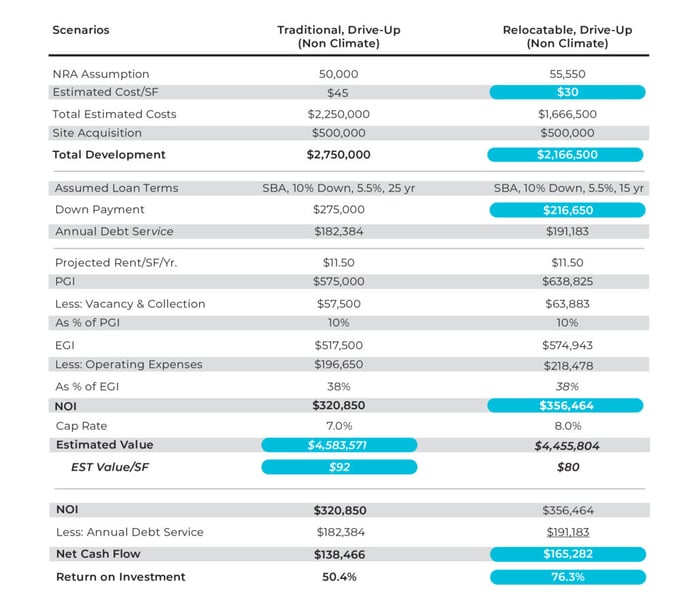Relocatable self-storage units offer a lot of the same (and more!) features as traditional units. First off, they are drive-up capable. They are also compatible with new entry and locking systems. With solid construction and updated features, relocatables are weather and rodent proof. And they can be color matched with roll up door installation for a seamless fit into your existing site. In fact, tenants are unable to distinguish the two. And they tend to rent them for equal terms. For instance, relocatable units achieve similar rents and occupancy rates as traditional units. What does that mean for you? Well, if relocatables are treated as equals in a market analysis, but cost less, your return will increase. In other words, it’s a win-win to choose relocatable storage units for your facility.
Another major positive for relocatables is land coverage. We look at the building-to-land ratio. Did you know that you can place relocatable storage units where traditional storage won’t fit? For example, place them on easements, excessive setbacks, areas in floodplains, and along fence lines. In other words, you can achieve greater net rentable area on a site with relocatable units. Relocatable storage units cost on average 33 percent to 50 percent less than traditional storage. More square footage at a lower cost equals higher income and greater profit!
It’s important to seek professional opinions from real estate professionals with experience in self-storage feasibility and valuation services. Consider a feasibility study, which is an assessment of the practicality of a proposed plan. It looks at the cost-benefit relationship at hand. (Sources: Oxford Languages online and The Appraisal of Real Estate). In a feasibility study, there are three main areas of consideration: supply and demand, physical feasibility, and financial feasibility.
Let’s consider how to research for a feasibility study. We look for both existing supply and pipeline supply. If positive demand exists for self-storage, then we perform a full market analysis. Here, we gather market info, such as rents, occupancy rates, absorption rates, and facility amenities. Positive demand justifies a need for storage. Next, we review the physical feasibility of the property. We create a hypothetical development using relocatable units. We review the physical feasibility and estimate the sample unit mix and facility size. At this point, the financial component begins.
When considering aesthetics, operation, and use, relocatable units are an equal counterpart to traditional self-storage units – with significant upsides. The choice between traditional or moveable storage depends largely upon site layout, location, timeframe, and budget. You may choose to have a mix of both traditional and relocatable storage, which is common for site expansions. Relocatable units are viable for new facilities, existing facility needing expansion, or for those looking to decrease costs. With all that flexibility, relocatables are increasing in popularity for good reason!

–
Adapted from “Feasibility and Relocatables: The Good, The Bad, and The Ugly” by Amanda Helfrich.
Amanda is the principal owner of Starr Commercial Real Estate, based out of Louisville, Kentucky. With complete focus and peak interest in this industry, Amanda has learned how to gauge a market for demand. She canvases an area for supply to research and locate proposed developments. She analyzes historical development trends and tracks absorption. From there, she provides realistic financial feasibility for a property.









